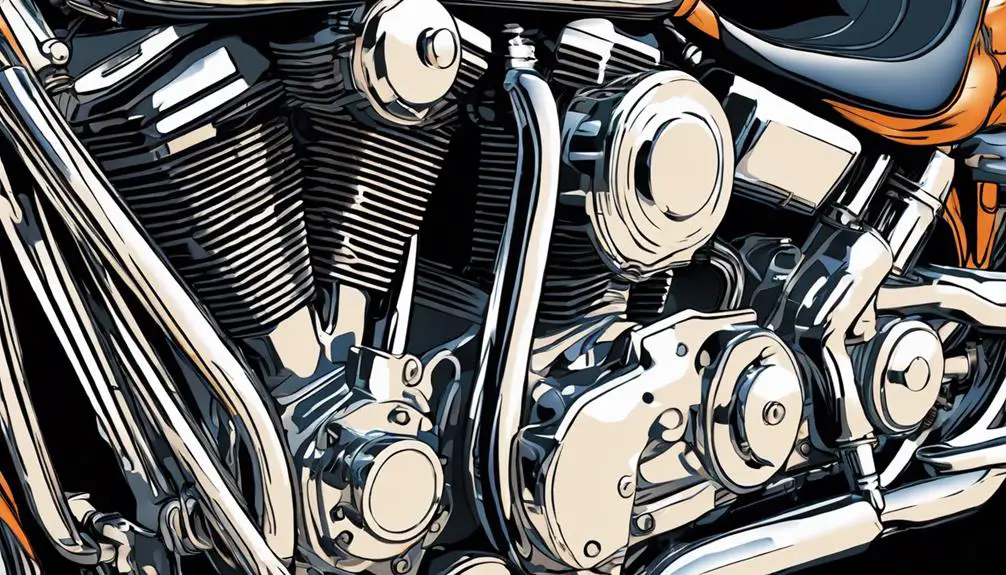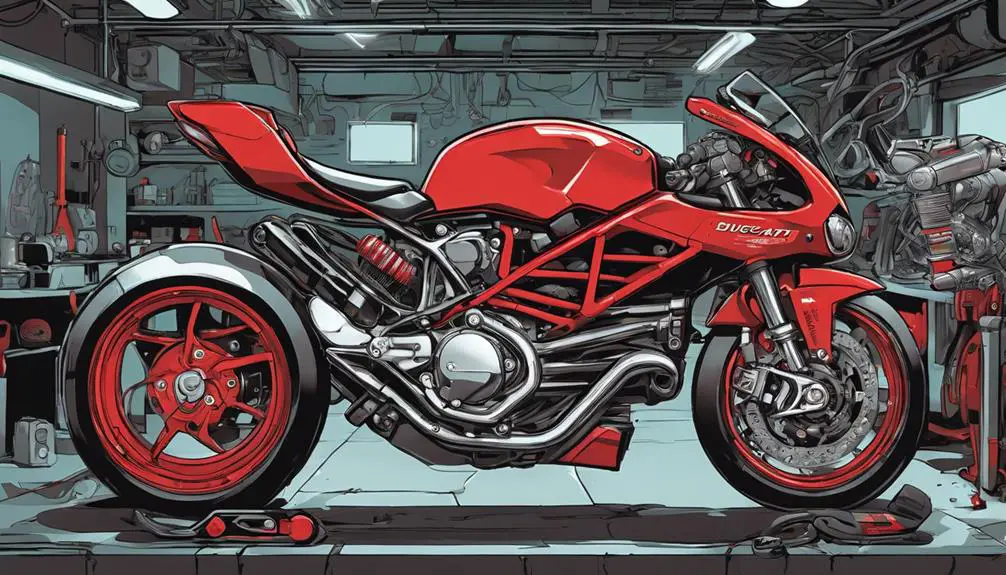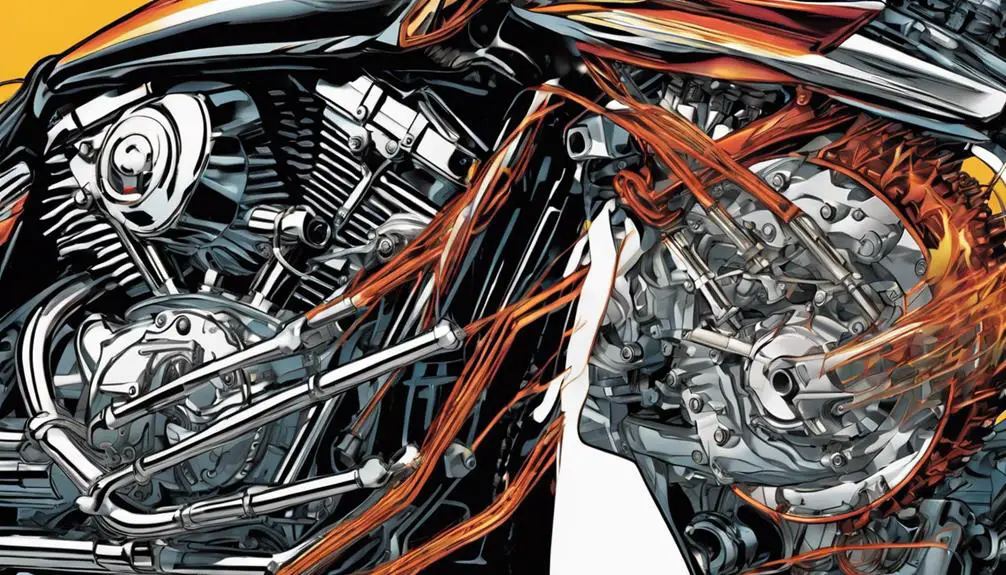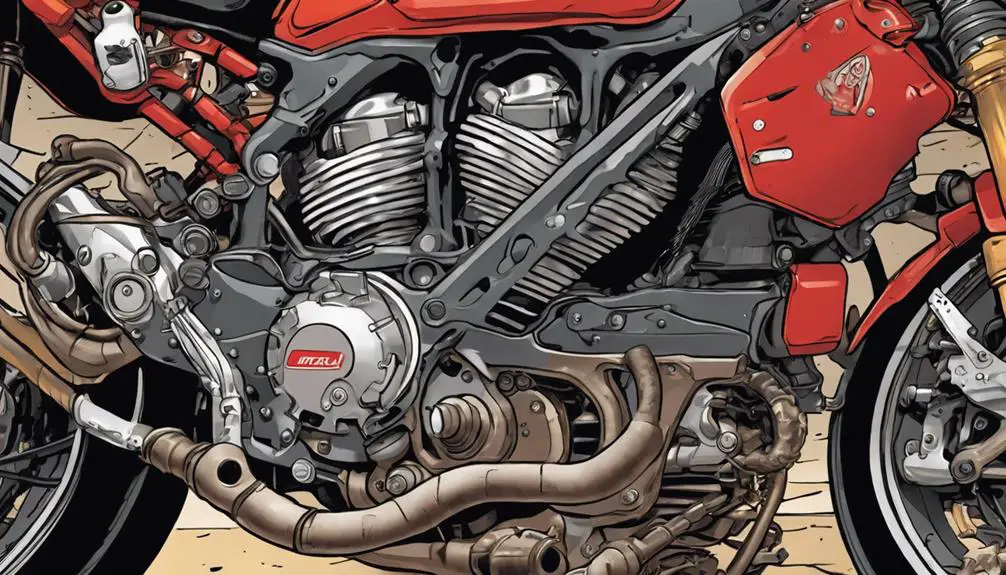Did you know that a motorcycle's horsepower can range from under 30 to over 200, depending on the model? While horsepower often gets the spotlight, torque plays an equally essential role in how your bike performs on the road. Understanding the balance between these two metrics can considerably impact your riding experience, especially when it comes to acceleration and handling. So, how do these figures translate into the thrill of riding, and what should you consider when choosing your next motorcycle?
Key Takeaways
- Horsepower determines a motorcycle's ability to achieve and maintain high speeds, essential for performance on highways and during overtaking.
- Torque provides the initial acceleration and power delivery, crucial for quick starts and navigating various terrains.
- A balance between horsepower and torque enhances overall riding experience, impacting responsiveness and handling of the motorcycle.
- Higher torque improves climbing ability and control, boosting rider confidence on hills and sharp turns.
Understanding Horsepower in Motorcycles

Horsepower in motorcycles measures how powerfully your bike can perform, affecting everything from acceleration to top speed. When you twist that throttle, you want your ride to respond with exhilarating speed, and that's where horsepower comes into play. It represents the engine's ability to convert fuel into motion, giving you the freedom to feel the wind against your face as your bike surges forward.
Higher horsepower means quicker acceleration, allowing you to break free from the constraints of the road. You'll experience the thrill of rapid takeoffs and the satisfaction of overtaking slower vehicles effortlessly. Whether you're cruising on a highway or tearing through winding back roads, your bike's horsepower empowers you to embrace the open road.
Understanding horsepower helps you choose the right motorcycle for your desires. If you crave liberation and adventure, look for bikes that offer a robust horsepower rating. Immerse yourself in the specs and get a feel for how your machine will perform.
In this world of two wheels, horsepower isn't just a number; it's the key to accessing your full riding potential, making every journey a bold expression of freedom.
The Role of Torque in Performance
Torque plays an essential role in how your motorcycle accelerates and handles, influencing your overall riding experience. When you twist the throttle, it's the torque that pushes you forward, helping you conquer steep hills and navigate tight corners with confidence. Higher torque means you can launch off the line quickly, giving you that exhilarating feeling of freedom.
Consider these key aspects of torque in performance:
- Acceleration: Strong torque provides quick power delivery, allowing you to accelerate faster, especially from a stop.
- Versatility: Bikes with good torque can perform well at a variety of speeds and terrains, enabling you to tackle diverse riding conditions.
Ultimately, understanding torque can transform your ride, giving you the power to feel liberated on the open road. It's not just about speed; it's about the connection between you and your machine, allowing you to fully embrace the thrill of riding.
Ducati Engine Specifications Overview

Ducati engines consistently deliver impressive performance characteristics that cater to both sport and touring riders alike.
Whether you're carving through twisty mountain roads or cruising down the highway, these engines provide the power and responsiveness you crave. The heart of a Ducati usually features a L-twin configuration, known for its distinct character and exhilarating torque delivery.
You'll notice that Ducatis often balance horsepower and torque to create an exhilarating riding experience. With options ranging from the nimble 803cc engine found in the Scrambler to the ferocious 1,262cc Testastretta DVT in the Multistrada, there's a Ducati engine tailored for every type of adventure.
As you rev up, you'll feel the torque surge that pushes you forward, allowing you to conquer the road with confidence. With high compression ratios and advanced fuel injection systems, Ducati engines guarantee you enjoy both efficiency and performance.
Embrace the liberation that comes from riding a Ducati, knowing that its engineering excellence supports your every twist of the throttle. Experience the thrill of the ride, where horsepower and torque seamlessly unite to create unforgettable journeys.
Key Ducati Models and Ratings
Several standout models showcase Ducati's commitment to performance, each offering unique horsepower and torque ratings that cater to different riding styles and preferences.
If you crave exhilarating speed, the Ducati Panigale V4 should be on your radar, boasting an impressive 214 horsepower and 91 lb-ft of torque. This beast is designed for those who want to push boundaries on the track.
For a more versatile ride, consider the Multistrada V4. With around 170 horsepower and 92 lb-ft of torque, it strikes a balance between power and comfort, making it perfect for both city commuting and long adventures.
Lastly, the Monster 1200 offers a thrilling experience with 147 horsepower and 87 lb-ft of torque, providing an agile and responsive ride for those who appreciate urban exploration.
Here's a quick look at key Ducati models:
- Panigale V4: 214 horsepower, 91 lb-ft torque
- Multistrada V4: 170 horsepower, 92 lb-ft torque
With these options, you're well-equipped to find the perfect Ducati that aligns with your liberating ride experience.
Comparing Horsepower and Torque

When you compare horsepower and torque, it's crucial to understand their definitions and differences.
Each plays a unique role in your motorcycle's performance and impacts your overall riding experience.
Definitions and Differences
Understanding the differences between horsepower and torque is fundamental for grasping motorcycle performance. While both terms are significant, they represent distinct concepts that shape your riding experience.
Torque measures the twisting force your engine generates. It's what gets you moving and helps you accelerate quickly. Think of it as the muscle behind your bike, giving you the power to climb hills or zip away from a stoplight.
Horsepower, on the other hand, is a measure of how quickly that torque can be applied over time. It reflects your bike's ability to maintain speed and power through various conditions. Basically, horsepower tells you how fast you can go when you're already moving.
Here's a quick breakdown:
- Torque: The initial push; fundamental for acceleration.
- Horsepower: The sustained power; significant for high-speed performance.
Impact on Performance
The balance between horsepower and torque directly influences your motorcycle's performance, affecting everything from acceleration to top speed.
When you twist the throttle, torque is what gets you moving off the line, providing that exhilarating push you feel as you accelerate. It's essential for quick starts and spirited rides through twisty roads. If your bike has high torque, you'll find it easier to conquer hills and navigate tight corners, giving you the freedom to explore on your terms.
On the other hand, horsepower comes into play at higher speeds. It determines how fast you can go once you're rolling. A motorcycle with more horsepower will allow you to reach and maintain those exhilarating top speeds, letting you experience the open road like never before.
Ultimately, the interplay between horsepower and torque creates a unique riding experience tailored to your style. If you crave quick bursts of speed and agility, focus on torque-rich bikes. If you're all about that high-speed thrill, look for machines with powerful horsepower.
Understanding this balance lets you choose a motorcycle that truly liberates your spirit on the road.
Riding Experience Factors
Comparing horsepower and torque reveals how each element shapes your riding experience, influencing everything from your bike's responsiveness to its overall feel on the road.
While horsepower is essential for achieving high speeds, torque delivers the power you crave during acceleration and climbing hills. Understanding this balance helps you choose a motorcycle that resonates with your spirit of freedom.
- Torque for Acceleration: Higher torque gives you the instant thrust you need when you twist the throttle, making your ride exhilarating and dynamic.
- Horsepower for Speed: If you're chasing the horizon, horsepower guarantees you can maintain higher speeds without straining your engine.
Impact on Riding Experience
When you twist the throttle, the balance of horsepower and torque directly influences your acceleration and speed.
This affects how your motorcycle handles, giving you control over tight corners and open roads.
Understanding this dynamic can enhance your riding experience considerably.
Acceleration and Speed
Acceleration and speed directly shape your riding experience, influencing how thrilling each twist of the throttle feels. When you release the power of your motorcycle, you can feel the adrenaline surge, propelling you into the open road. The exhilaration of rapid acceleration gives you a sense of liberation, making every ride a celebration of freedom.
Understanding how horsepower and torque contribute to acceleration can enhance your experience. Here's what you should know:
- Immediate Response: Higher horsepower often means quicker acceleration, allowing you to reach your desired speed without hesitation.
- Rider Confidence: The feeling of speed can boost your confidence, helping you tackle straightaways and exhilarating curves with ease.
When you ride, it's not just about moving from point A to B; it's about the thrill of the journey. Embrace the power beneath you, and let each ride remind you of the freedom that awaits on the open road.
Ride fast, ride free!
Handling and Control
While speed thrills, the way your motorcycle handles and responds to your control is what truly defines your riding experience. You want a bike that feels like an extension of yourself, allowing you to carve through corners and navigate tight spaces with confidence. Good handling means your motorcycle reacts predictably to your inputs, whether you're leaning into a turn or accelerating out of one.
Torque plays a key role here. It gives you that immediate power to pull out of corners smoothly, while horsepower helps maintain your speed. When both are in harmony, you can release your spirit on the open road, feeling the freedom of the ride.
Don't underestimate the importance of suspension and weight distribution, either. A well-balanced motorcycle absorbs bumps and maintains stability, letting you focus on the thrill of the journey instead of wrestling with your bike.
Ultimately, handling and control shape your connection with the road. They empower you to explore new horizons, embrace the curves, and transform every ride into a liberating adventure.
Common Ducati Engine Issues

Ducati motorcycles, known for their performance, can sometimes face specific engine issues that every owner should be aware of. Understanding these problems can empower you to maintain your bike effectively and enjoy the ride without worry.
Here are some common engine issues you might encounter:
- Cam Belt Wear: If not replaced at recommended intervals, cam belts can wear out, leading to engine failure.
- Oil Leaks: These can stem from various sources like gaskets or seals. Regularly checking for oil spots can help you catch issues early.
Being aware of these potential issues allows you to take proactive steps. You don't have to be a mechanic, but keeping an eye on your bike's performance can save you from more significant headaches down the road.
Embrace the freedom of the open road, but remember that a little vigilance goes a long way in ensuring your Ducati remains the powerful machine you fell in love with. Stay informed, and you'll keep that spirit alive!
Importance of Maintenance and Tuning
Understanding engine issues is just the beginning; regular maintenance and tuning are crucial for keeping your motorcycle performing at its best. You crave that feeling of freedom on the open road, and staying on top of your bike's needs is key to achieving it. Proper maintenance guarantees that your horsepower and torque stay at peak levels, allowing you to release your machine's true potential.
Regular oil changes, air filter replacements, and spark plug checks aren't just routine tasks; they're your ticket to a reliable ride. Neglecting these can lead to sluggish performance and decreased efficiency, stifling the thrill of the journey. Tuning, on the other hand, fine-tunes the balance between horsepower and torque, giving you the responsiveness and power you crave.
When you invest time in maintenance, you're not just preserving your bike; you're enhancing your riding experience. A well-tuned motorcycle delivers smoother acceleration and better handling, allowing you to feel the wind in your face without worrying about engine hiccups.
Frequently Asked Questions
How Do Horsepower and Torque Affect Fuel Efficiency?
Horsepower and torque play essential roles in a motorcycle's fuel efficiency.
Higher horsepower often means more power for acceleration, but it can lead to increased fuel consumption if you're not careful.
Torque, on the other hand, helps you maintain speed at lower RPMs, which can enhance efficiency.
Can Modifications Increase Horsepower and Torque Significantly?
Absolutely, modifications can greatly boost your motorcycle's horsepower and torque.
By upgrading components like the exhaust, air filter, or tuning the engine, you can release more power.
Don't forget about lightweight materials; shedding weight enhances performance too.
Each change can lead to a noticeable difference in how your bike feels and rides.
Just remember, balancing power and control is key to enjoying the freedom of the open road safely!
What Is the Relationship Between Engine Size and Horsepower?
Think of engine size as a canvas. The bigger the canvas, the more vibrant the painting.
In motorcycles, larger engines generally produce more horsepower because they can burn more fuel and air, creating more power. It's like releasing a wild stallion—more size often means more strength.
However, it's not just about size; efficiency and design matter too.
Do Different Riding Styles Require Different Horsepower and Torque?
Absolutely, different riding styles require varying levels of horsepower and torque.
If you're cruising on highways, you'll want a bike with solid torque for smooth acceleration.
For aggressive cornering or off-road adventures, a bike with higher horsepower can give you the edge you need.
Understanding your riding style helps you choose the right bike, ensuring you feel liberated and in control, whether you're carving through curves or blasting down straightaways.
How Do Weather Conditions Impact Horsepower and Torque Performance?
Weather conditions can have a huge impact on your bike's performance.
When it's hot and humid, your engine might struggle with overheating, reducing horsepower.
Rain or snow can affect traction, making it harder for you to harness that power effectively.
Cold weather can thicken oil, leading to sluggish performance.
Conclusion
In the thrilling world of motorcycles, horsepower and torque aren't just numbers; they're the heartbeat of your ride.
They shape your experience, turning every twist of the throttle into an adrenaline-fueled adventure.
When you understand their importance, you reveal the true potential of your bike, making each journey feel like you're soaring through the clouds.
So, embrace the power beneath you, and let every ride be an unforgettable symphony of speed and control.